Jinbo Wen
LMM-Incentive: Large Multimodal Model-based Incentive Design for User-Generated Content in Web 3.0
Oct 06, 2025Abstract:Web 3.0 represents the next generation of the Internet, which is widely recognized as a decentralized ecosystem that focuses on value expression and data ownership. By leveraging blockchain and artificial intelligence technologies, Web 3.0 offers unprecedented opportunities for users to create, own, and monetize their content, thereby enabling User-Generated Content (UGC) to an entirely new level. However, some self-interested users may exploit the limitations of content curation mechanisms and generate low-quality content with less effort, obtaining platform rewards under information asymmetry. Such behavior can undermine Web 3.0 performance. To this end, we propose \textit{LMM-Incentive}, a novel Large Multimodal Model (LMM)-based incentive mechanism for UGC in Web 3.0. Specifically, we propose an LMM-based contract-theoretic model to motivate users to generate high-quality UGC, thereby mitigating the adverse selection problem from information asymmetry. To alleviate potential moral hazards after contract selection, we leverage LMM agents to evaluate UGC quality, which is the primary component of the contract, utilizing prompt engineering techniques to improve the evaluation performance of LMM agents. Recognizing that traditional contract design methods cannot effectively adapt to the dynamic environment of Web 3.0, we develop an improved Mixture of Experts (MoE)-based Proximal Policy Optimization (PPO) algorithm for optimal contract design. Simulation results demonstrate the superiority of the proposed MoE-based PPO algorithm over representative benchmarks in the context of contract design. Finally, we deploy the designed contract within an Ethereum smart contract framework, further validating the effectiveness of the proposed scheme.
Confidence-Regulated Generative Diffusion Models for Reliable AI Agent Migration in Vehicular Metaverses
May 19, 2025Abstract:Vehicular metaverses are an emerging paradigm that merges intelligent transportation systems with virtual spaces, leveraging advanced digital twin and Artificial Intelligence (AI) technologies to seamlessly integrate vehicles, users, and digital environments. In this paradigm, vehicular AI agents are endowed with environment perception, decision-making, and action execution capabilities, enabling real-time processing and analysis of multi-modal data to provide users with customized interactive services. Since vehicular AI agents require substantial resources for real-time decision-making, given vehicle mobility and network dynamics conditions, the AI agents are deployed in RoadSide Units (RSUs) with sufficient resources and dynamically migrated among them. However, AI agent migration requires frequent data exchanges, which may expose vehicular metaverses to potential cyber attacks. To this end, we propose a reliable vehicular AI agent migration framework, achieving reliable dynamic migration and efficient resource scheduling through cooperation between vehicles and RSUs. Additionally, we design a trust evaluation model based on the theory of planned behavior to dynamically quantify the reputation of RSUs, thereby better accommodating the personalized trust preferences of users. We then model the vehicular AI agent migration process as a partially observable markov decision process and develop a Confidence-regulated Generative Diffusion Model (CGDM) to efficiently generate AI agent migration decisions. Numerical results demonstrate that the CGDM algorithm significantly outperforms baseline methods in reducing system latency and enhancing robustness against cyber attacks.
Generative AI for Data Augmentation in Wireless Networks: Analysis, Applications, and Case Study
Nov 13, 2024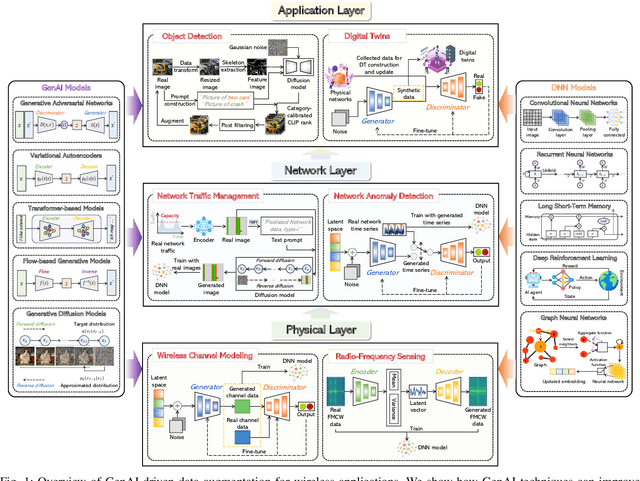
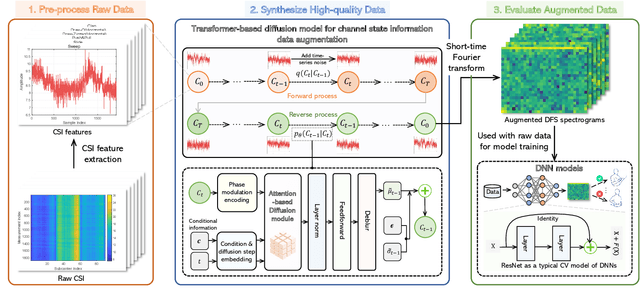
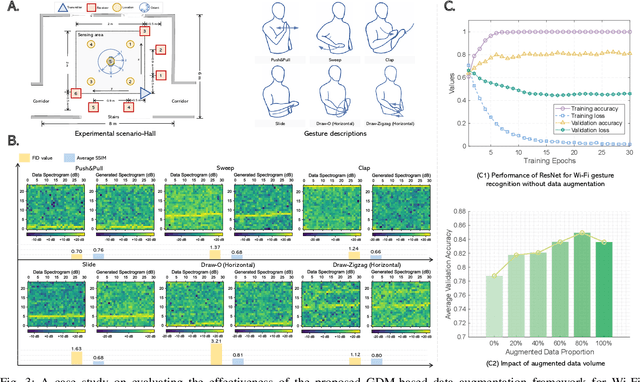
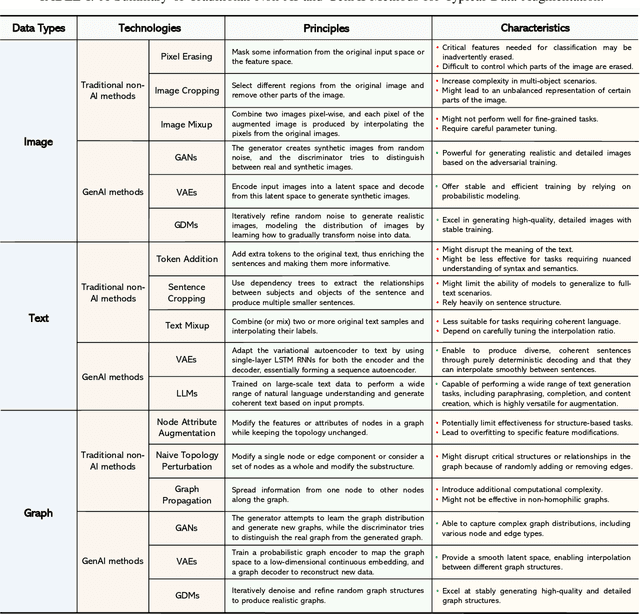
Abstract:Data augmentation is a powerful technique to mitigate data scarcity. However, owing to fundamental differences in wireless data structures, traditional data augmentation techniques may not be suitable for wireless data. Fortunately, Generative Artificial Intelligence (GenAI) can be an effective alternative to wireless data augmentation due to its excellent data generation capability. This article systemically explores the potential and effectiveness of GenAI-driven data augmentation in wireless networks. We first briefly review data augmentation techniques, discuss their limitations in wireless networks, and introduce generative data augmentation, including reviewing GenAI models and their applications in data augmentation. We then explore the application prospects of GenAI-driven data augmentation in wireless networks from the physical, network, and application layers, which provides a GenAI-driven data augmentation architecture for each application. Subsequently, we propose a general generative diffusion model-based data augmentation framework for Wi-Fi gesture recognition, which uses transformer-based diffusion models to generate high-quality channel state information data. Furthermore, we develop residual neural network models for Wi-Fi gesture recognition to evaluate the role of augmented data and conduct a case study based on a real dataset. Simulation results demonstrate the effectiveness of the proposed framework. Finally, we discuss research directions for generative data augmentation.
Generative Diffusion-based Contract Design for Efficient AI Twins Migration in Vehicular Embodied AI Networks
Oct 02, 2024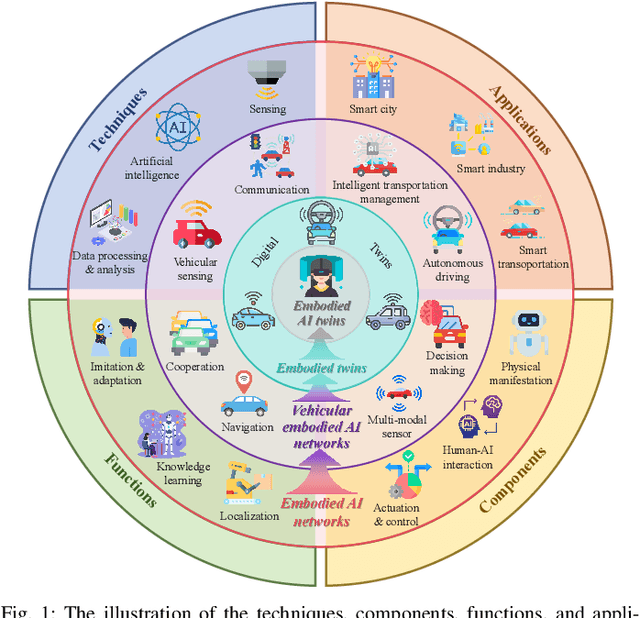
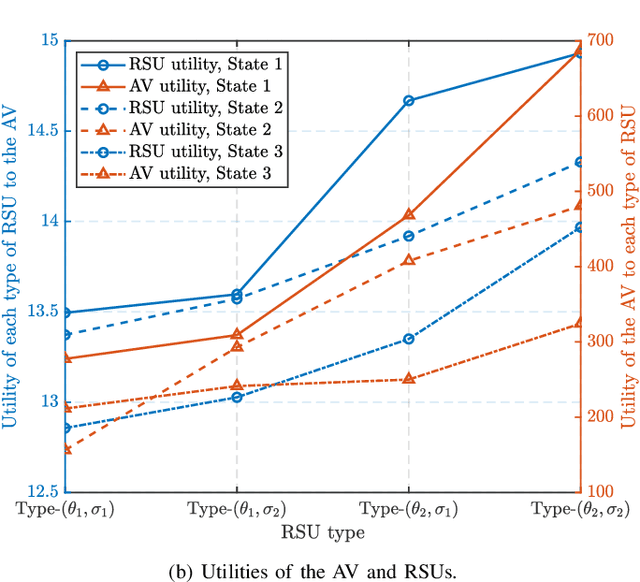
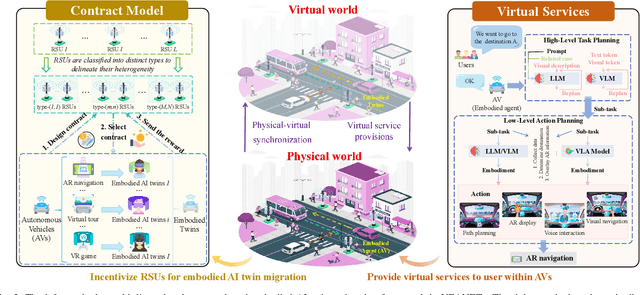
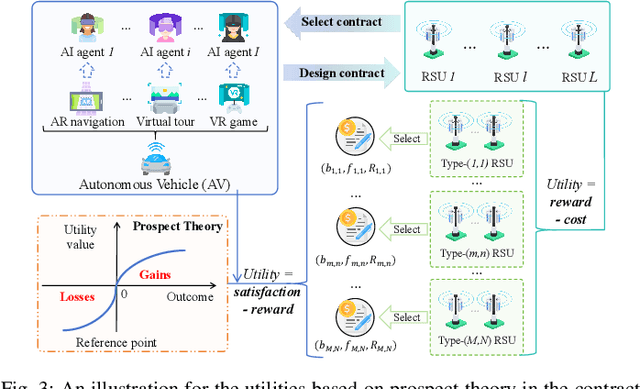
Abstract:Embodied AI is a rapidly advancing field that bridges the gap between cyberspace and physical space, enabling a wide range of applications. This evolution has led to the development of the Vehicular Embodied AI NETwork (VEANET), where advanced AI capabilities are integrated into vehicular systems to enhance autonomous operations and decision-making. Embodied agents, such as Autonomous Vehicles (AVs), are autonomous entities that can perceive their environment and take actions to achieve specific goals, actively interacting with the physical world. Embodied twins are digital models of these embodied agents, with various embodied AI twins for intelligent applications in cyberspace. In VEANET, embodied AI twins act as in-vehicle AI assistants to perform diverse tasks supporting autonomous driving using generative AI models. Due to limited computational resources of AVs, these AVs often offload computationally intensive tasks, such as constructing and updating embodied AI twins, to nearby RSUs. However, since the rapid mobility of AVs and the limited provision coverage of a single RSU, embodied AI twins require dynamic migrations from current RSU to other RSUs in real-time, resulting in the challenge of selecting suitable RSUs for efficient embodied AI twins migrations. Given information asymmetry, AVs cannot know the detailed information of RSUs. To this end, in this paper, we construct a multi-dimensional contract theoretical model between AVs and alternative RSUs. Considering that AVs may exhibit irrational behavior, we utilize prospect theory instead of expected utility theory to model the actual utilities of AVs. Finally, we employ a generative diffusion model-based algorithm to identify the optimal contract designs. Compared with traditional deep reinforcement learning algorithms, numerical results demonstrate the effectiveness of the proposed scheme.
Sustainable Diffusion-based Incentive Mechanism for Generative AI-driven Digital Twins in Industrial Cyber-Physical Systems
Aug 02, 2024



Abstract:Industrial Cyber-Physical Systems (ICPSs) are an integral component of modern manufacturing and industries. By digitizing data throughout the product life cycle, Digital Twins (DTs) in ICPSs enable a shift from current industrial infrastructures to intelligent and adaptive infrastructures. Thanks to data process capability, Generative Artificial Intelligence (GAI) can drive the construction and update of DTs to improve predictive accuracy and prepare for diverse smart manufacturing. However, mechanisms that leverage sensing Industrial Internet of Things (IIoT) devices to share data for the construction of DTs are susceptible to adverse selection problems. In this paper, we first develop a GAI-driven DT architecture for ICPSs. To address the adverse selection problem caused by information asymmetry, we propose a contract theory model and develop the sustainable diffusion-based soft actor-critic algorithm to identify the optimal feasible contract. Specifically, we leverage the dynamic structured pruning technique to reduce parameter numbers of actor networks, allowing sustainability and efficient implementation of the proposed algorithm. Finally, numerical results demonstrate the effectiveness of the proposed scheme.
Hybrid RAG-empowered Multi-modal LLM for Secure Healthcare Data Management: A Diffusion-based Contract Theory Approach
Jul 01, 2024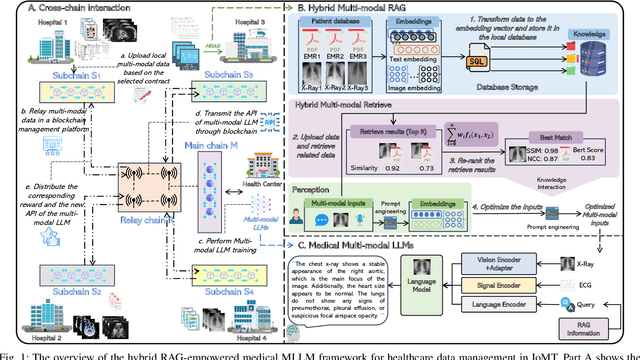
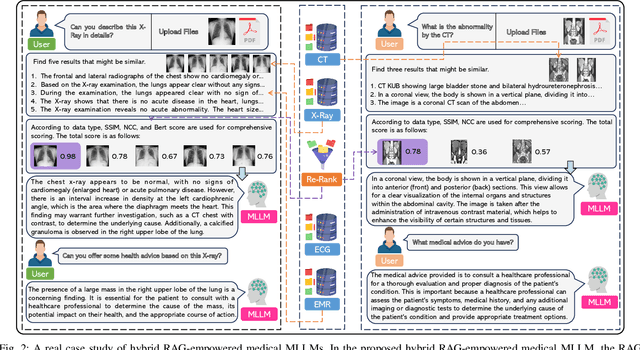
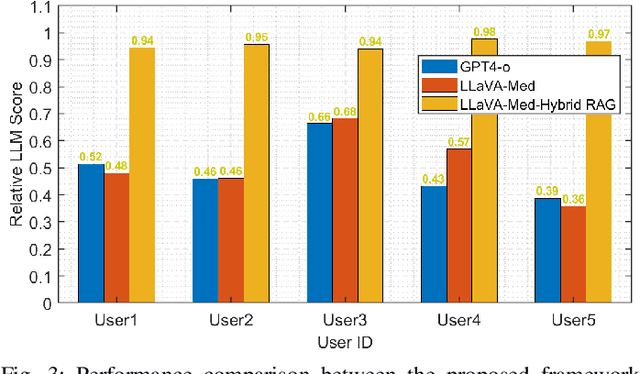
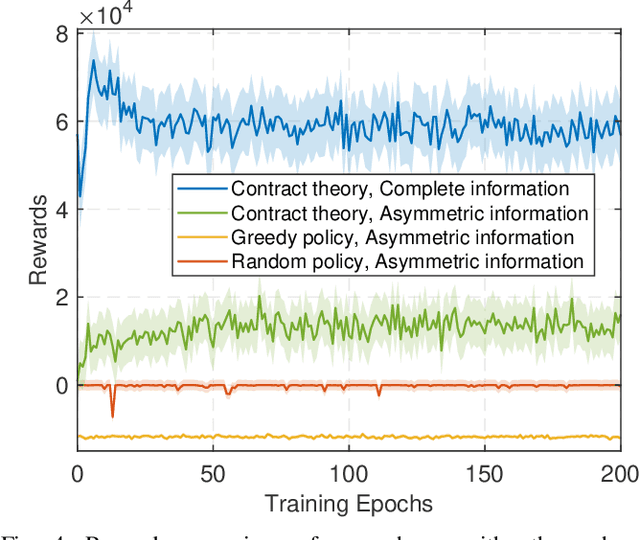
Abstract:Secure data management and effective data sharing have become paramount in the rapidly evolving healthcare landscape. The advancement of generative artificial intelligence has positioned Multi-modal Large Language Models (MLLMs) as crucial tools for managing healthcare data. MLLMs can support multi-modal inputs and generate diverse types of content by leveraging large-scale training on vast amounts of multi-modal data. However, critical challenges persist in developing medical MLLMs, including healthcare data security and freshness issues, affecting the output quality of MLLMs. In this paper, we propose a hybrid Retrieval-Augmented Generation (RAG)-empowered medical MLLMs framework for healthcare data management. This framework leverages a hierarchical cross-chain architecture to facilitate secure data training. Moreover, it enhances the output quality of MLLMs through hybrid RAG, which employs multi-modal metrics to filter various unimodal RAG results and incorporates these retrieval results as additional inputs to MLLMs. Additionally, we employ age of information to indirectly evaluate the data freshness impact of MLLMs and utilize contract theory to incentivize healthcare data holders to share fresh data, mitigating information asymmetry in data sharing. Finally, we utilize a generative diffusion model-based reinforcement learning algorithm to identify the optimal contract for efficient data sharing. Numerical results demonstrate the effectiveness of the proposed schemes, which achieve secure and efficient healthcare data management.
Generative AI for Low-Carbon Artificial Intelligence of Things
Apr 28, 2024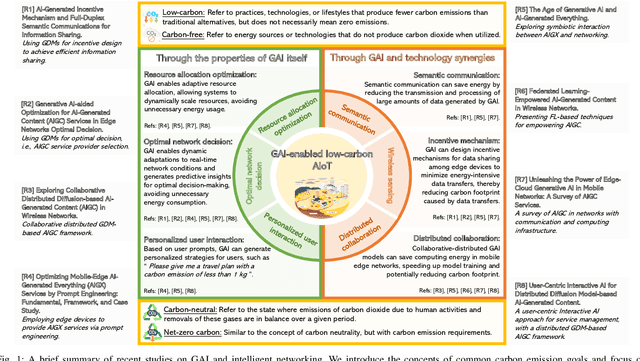
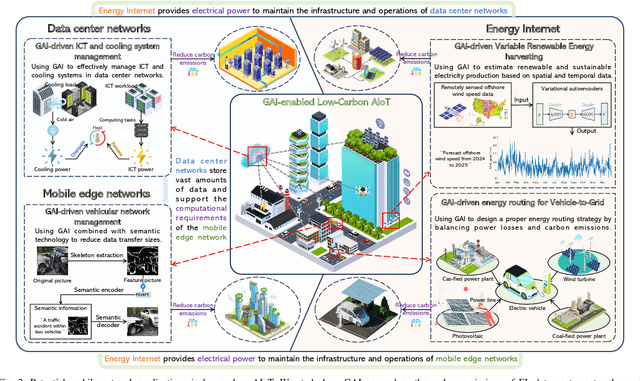
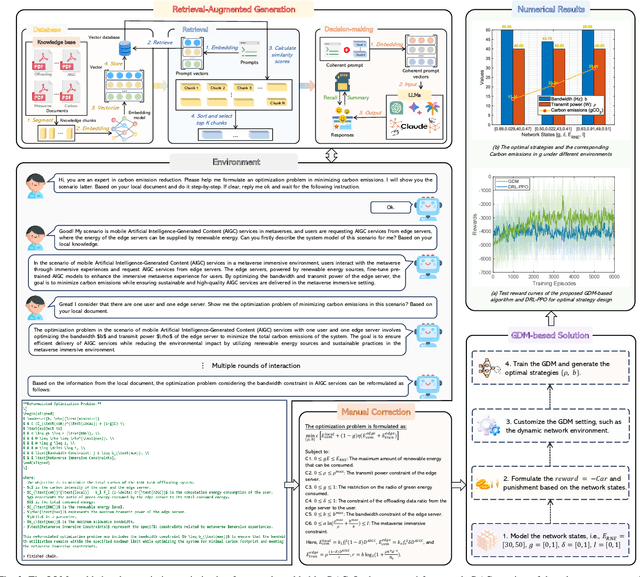
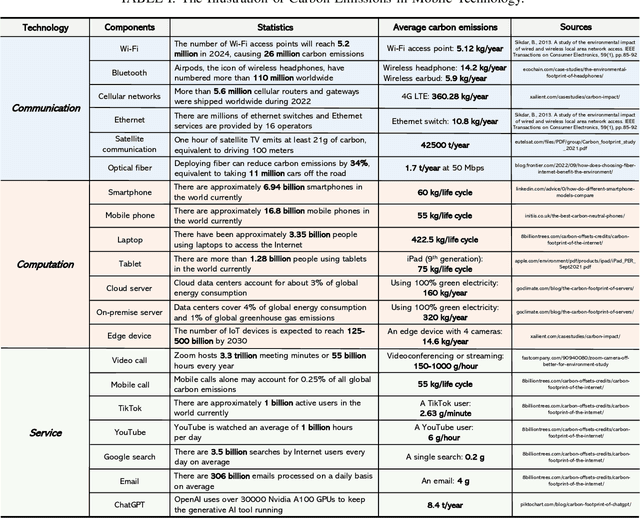
Abstract:By integrating Artificial Intelligence (AI) with the Internet of Things (IoT), Artificial Intelligence of Things (AIoT) has revolutionized many fields. However, AIoT is facing the challenges of energy consumption and carbon emissions due to the continuous advancement of mobile technology. Fortunately, Generative AI (GAI) holds immense potential to reduce carbon emissions of AIoT due to its excellent reasoning and generation capabilities. In this article, we explore the potential of GAI for carbon emissions reduction and propose a novel GAI-enabled solution for low-carbon AIoT. Specifically, we first study the main impacts that cause carbon emissions in AIoT, and then introduce GAI techniques and their relations to carbon emissions. We then explore the application prospects of GAI in low-carbon AIoT, focusing on how GAI can reduce carbon emissions of network components. Subsequently, we propose a Large Language Model (LLM)-enabled carbon emission optimization framework, in which we design pluggable LLM and Retrieval Augmented Generation (RAG) modules to generate more accurate and reliable optimization problems. Furthermore, we utilize Generative Diffusion Models (GDMs) to identify optimal strategies for carbon emission reduction. Simulation results demonstrate the effectiveness of the proposed framework. Finally, we insightfully provide open research directions for low-carbon AIoT.
Tiny Multi-Agent DRL for Twins Migration in UAV Metaverses: A Multi-Leader Multi-Follower Stackelberg Game Approach
Jan 18, 2024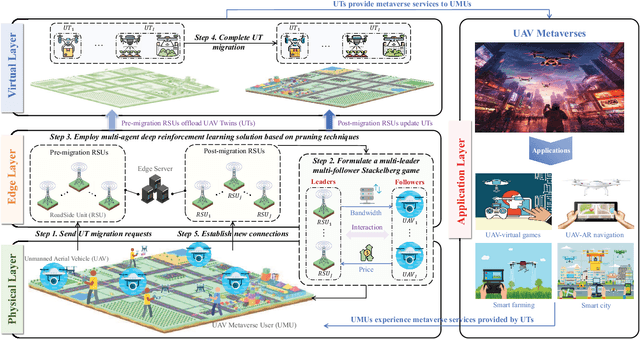
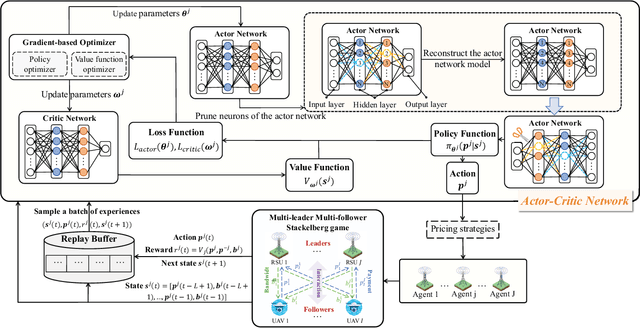
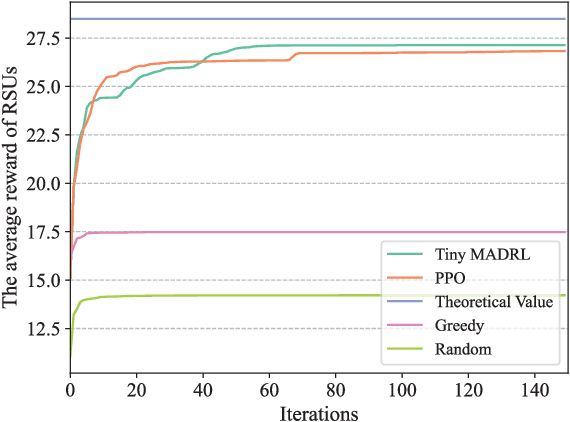
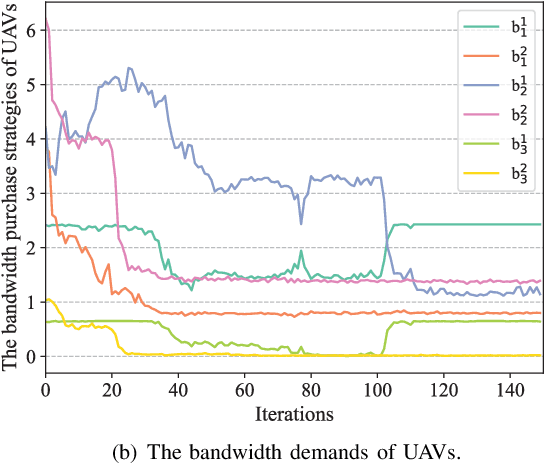
Abstract:The synergy between Unmanned Aerial Vehicles (UAVs) and metaverses is giving rise to an emerging paradigm named UAV metaverses, which create a unified ecosystem that blends physical and virtual spaces, transforming drone interaction and virtual exploration. UAV Twins (UTs), as the digital twins of UAVs that revolutionize UAV applications by making them more immersive, realistic, and informative, are deployed and updated on ground base stations, e.g., RoadSide Units (RSUs), to offer metaverse services for UAV Metaverse Users (UMUs). Due to the dynamic mobility of UAVs and limited communication coverages of RSUs, it is essential to perform real-time UT migration to ensure seamless immersive experiences for UMUs. However, selecting appropriate RSUs and optimizing the required bandwidth is challenging for achieving reliable and efficient UT migration. To address the challenges, we propose a tiny machine learning-based Stackelberg game framework based on pruning techniques for efficient UT migration in UAV metaverses. Specifically, we formulate a multi-leader multi-follower Stackelberg model considering a new immersion metric of UMUs in the utilities of UAVs. Then, we design a Tiny Multi-Agent Deep Reinforcement Learning (Tiny MADRL) algorithm to obtain the tiny networks representing the optimal game solution. Specifically, the actor-critic network leverages the pruning techniques to reduce the number of network parameters and achieve model size and computation reduction, allowing for efficient implementation of Tiny MADRL. Numerical results demonstrate that our proposed schemes have better performance than traditional schemes.
Resource-efficient Generative Mobile Edge Networks in 6G Era: Fundamentals, Framework and Case Study
Dec 19, 2023Abstract:As the next-generation wireless communication system, Sixth-Generation (6G) technologies are emerging, enabling various mobile edge networks that can revolutionize wireless communication and connectivity. By integrating Generative Artificial Intelligence (GAI) with mobile edge networks, generative mobile edge networks possess immense potential to enhance the intelligence and efficiency of wireless communication networks. In this article, we propose the concept of generative mobile edge networks and overview widely adopted GAI technologies and their applications in mobile edge networks. We then discuss the potential challenges faced by generative mobile edge networks in resource-constrained scenarios. To address these challenges, we develop a universal resource-efficient generative incentive mechanism framework, in which we design resource-efficient methods for network overhead reduction, formulate appropriate incentive mechanisms for the resource allocation problem, and utilize Generative Diffusion Models (GDMs) to find the optimal incentive mechanism solutions. Furthermore, we conduct a case study on resource-constrained mobile edge networks, employing model partition for efficient AI task offloading and proposing a GDM-based Stackelberg model to motivate edge devices to contribute computing resources for mobile edge intelligence. Finally, we propose several open directions that could contribute to the future popularity of generative mobile edge networks.
From Generative AI to Generative Internet of Things: Fundamentals, Framework, and Outlooks
Oct 27, 2023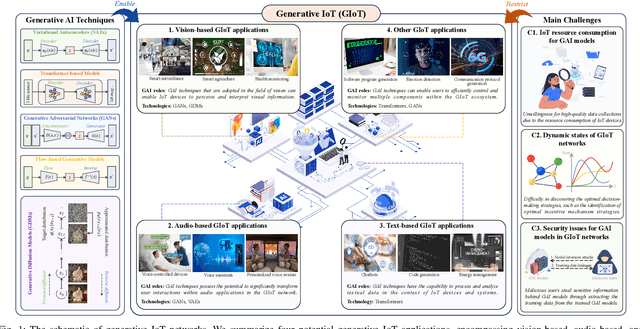
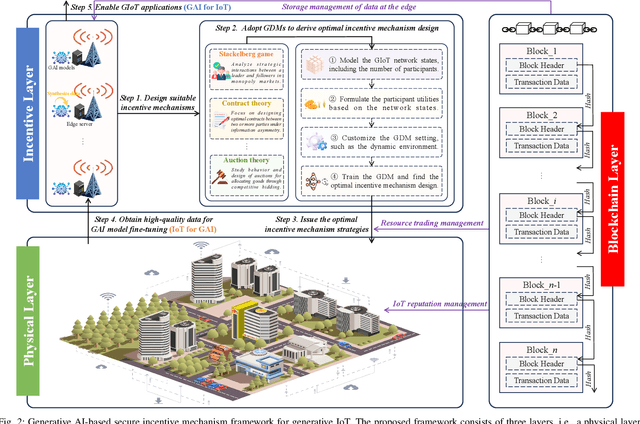
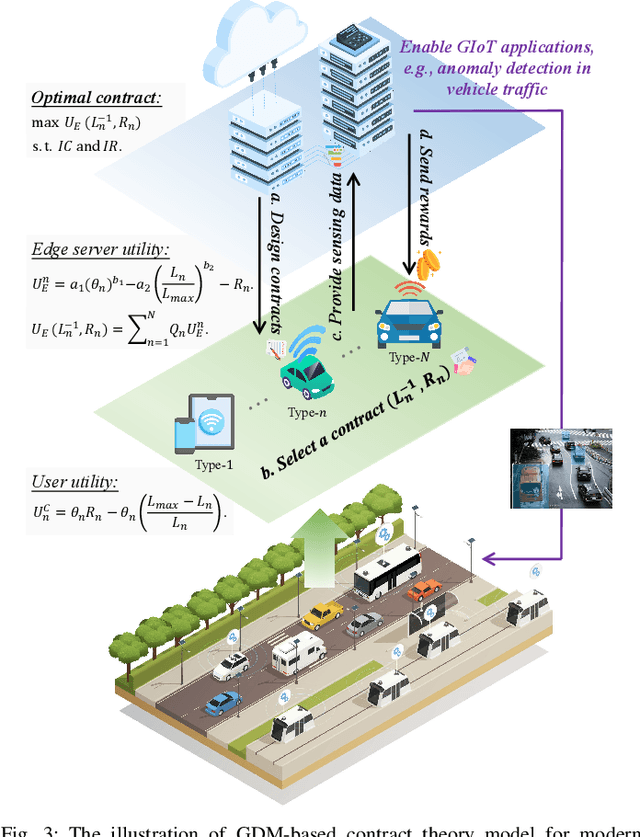
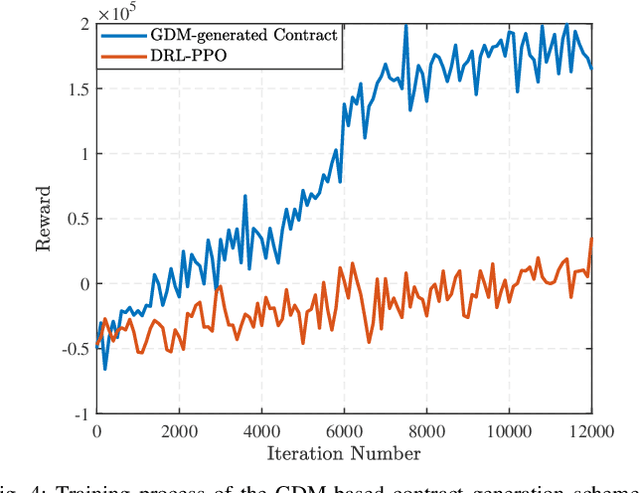
Abstract:Generative Artificial Intelligence (GAI) possesses the capabilities of generating realistic data and facilitating advanced decision-making. By integrating GAI into modern Internet of Things (IoT), Generative Internet of Things (GIoT) is emerging and holds immense potential to revolutionize various aspects of society, enabling more efficient and intelligent IoT applications, such as smart surveillance and voice assistants. In this article, we present the concept of GIoT and conduct an exploration of its potential prospects. Specifically, we first overview four GAI techniques and investigate promising GIoT applications. Then, we elaborate on the main challenges in enabling GIoT and propose a general GAI-based secure incentive mechanism framework to address them, in which we adopt Generative Diffusion Models (GDMs) for incentive mechanism designs and apply blockchain technologies for secure GIoT management. Moreover, we conduct a case study on modern Internet of Vehicle traffic monitoring, which utilizes GDMs to generate effective contracts for incentivizing users to contribute sensing data with high quality. Finally, we suggest several open directions worth investigating for the future popularity of GIoT.
 Add to Chrome
Add to Chrome Add to Firefox
Add to Firefox Add to Edge
Add to Edge